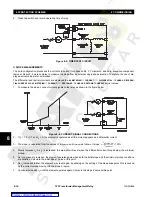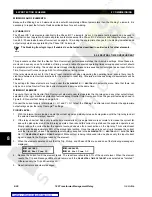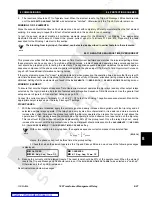
8-28
745 Transformer Management Relay
GE Multilin
8.5 PROTECTION SCHEMES
8 COMMISSIONING
8
OPERATING TIME:
Using a table like the one shown below, select 3 or 4 values of current multiples at which the timing is to be measured.
Enter the expected operating times from the timing curve applied in the settings. Using the setup in Figure 8–9: General
Test Setup on page 8–18 with the Interval Timer enabled, set the current level to the desired value (taking into account the
relationship mentioned above) and apply suddenly by closing the double-pole switch. Record the operate time and com-
pare to the expected value. Repeat for all desired values of current.
RESET TIME:
A simple verification of which reset mode, selected with the
S4 ELEMENTS
ÖØ
NEG SEQ OC
Ö
W1 NEG SEQ TIME OC
ÖØ
W1
NEG SEQ TIME OC RESET
setpoint, can be obtained using the simple test setup in Figure 8–9: General Test Setup on page 8–
18. The procedure consists of repetitive operating time measurements in quick succession. If the reset is selected for
“Instantaneous”, the operating time is always equal to the nominal time derived from the selected curve. If the reset is
selected as “Linear”, the operating time varies as a function of the time between successive applications of the current sig-
nal. If this test is performed at current multiples of 2 to 3 times the pickup level, the variations in operating time are easier to
detect.
WINDING 2 AND 3 ELEMENTS:
Because the Negative Sequence TOC elements on Windings 2 and/or 3 can be set with completely different parameters
than those for the first element, it is necessary to repeat the full set of tests described in this section for each winding.
To test these elements, disable all protection elements except for Winding 2 Negative Sequence Time Overcurrent. Con-
nect the current signal to X = H4 and Y = G4. Repeat all the tests described for the Winding 1 element in this section. For
Winding 3, connect the current signal to X = H7 and Y = G7.
The blocking from logic input, if enabled, can be tested as described in earlier tests for other elements.
8.5.12 NEGATIVE SEQUENCE INSTANTANEOUS OVERCURRENT
This procedure verifies that the Negative Sequence Instantaneous Overcurrent performance matches the in-service set-
tings. These elements are found under the
S4 ELEMENTS
ÖØ
NEG SEQ OC
ÖØ
W1 NEG SEQ INST OC
settings menu.
If the relay settings require testing at current multiples of several times the rated CT secondary value,
do not leave the cur-
rent signal on for more than a few seconds.
WINDING 1 ELEMENT:
To ensure that only the Negative Sequence Instantaneous Overcurrent element operates the trip relays (and any other out-
put relays selected by the logic), disable all protection features except Negative Sequence Instantaneous Overcurrent. Use
the general test setup in Figure 8–9: General Test Setup on page 8–18.
Connect the current supply to terminals X = H1 and Y = G1 to test the Winding 1 element. Monitor the appropriate output
relays as per the relay FlexLogic™ settings.
PICKUP LEVEL:
1.
With the interval timer disabled, apply the current signal and increase its magnitude until the trip relay and all selected
auxiliary relays operate. Compare the measured operating level against the
S4 ELEMENTS
ÖØ
NEG SEQ OC
ÖØ
W1 NEG
SEQ INST OC
ÖØ
W1 NEG SEQ INST OC PICKUP
relay settings.
With current applied to a single phase, the negative sequence current component is calculated from:
(EQ 8.15)
CURRENT
MULTIPLE
NOMINAL TIME
MEASURED
TIME
1.5
3
5
NOTE
NOTE
I
neg
seq
1
3
---
I
phase
×
=
Содержание TRANSFORMER MANAGEMENT RELAY 745
Страница 2: ...Courtesy of NationalSwitchgear com ...
















































